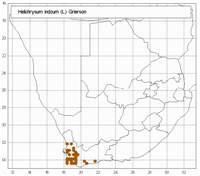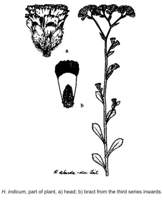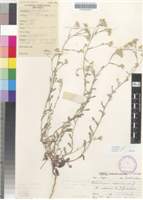Origin of name:
indicus /-a/-um = Indian
Diagnostic characters:
Branched flower headsWhite-cream bractsMedium-sized heads
Description:
Annual herb with a woody taproot, stems mostly 70�30 mm long, erect or spreading, subsimple or well-branched from the base, thinly white-woolly, leafy. Leaves very variable in size, lowermost up to 50 x 12 mm, upper mostly c. 10�15 x 2�5 mm, spathulate or oblong-spathulate to linear, base narrowed, apex subacute, mucronate, both surfaces greyish-white woolly. Heads homogamous or very rarely heterogamous, cylindric-campanulate, c. 3 x 2 mm, few to many on short stalks crowded at the branch tips, these often in loose corymbose panicles. Involucral bracts in 5�6 series, loosely imbricate, outer short, pellucid, acute, pale brown or occasionally reddish, bases loosely woolly, inner longer, sub-equal, about equaling flowers, tips opaque milk-white, sometimes suffused pink, or crimson above the stereome, or rarely creamy, very obtuse, crisped, minutely radiating. Receptacle smooth or nearly so. Flowers 14�27, occasionally 1 or 2 female. Achenes 0.75 mm long, usually with myxogenic duplex hairs or occasionally glabrous. Pappus bristles many, equaling corolla, scabrid, bases cohering lightly by patent cilia.
Flowers between October and February.
Distribution:
Grows on sandy flats and slopes and will become a weed in rough or cultivated ground. Endemic to the SW. Cape, from Lambert's Bay and Clanwilliam south to Betty's Bay and Swellendam.
Fynbos Biome.
Notes:
Levyns (in Adamson & Salter, Fl. Cape Penins. 780, 1950) says 'It seems likely that this species hybridizes with H. rutilans' [that is, H. moeserianum]. Levyns 8545 (BOL) has faintly yellowish, not pure white, bracts, and could be of hybrid origin as Mrs. Levyns suggests; however, pollen and ovules appear to be normal.
Taxonomy:
Literature:
Helichrysum indicum (L.) Grierson in Notes R. bot. Gdn Edinb. 31:138 (1971).
Type:
Lectotype: from the Cape of Good Hope, Hermann herbarium 4: 15, no. 307 (BM).
Synonym(s):
Gnaphalium indicum L., Sp. PI. 852 (1753), non al.
G. paniculatum Berg., Descr. PI. Cap. 256 (1767), non Thunb. (1823). Type: Cape of Good Hope, Grubb (STB, holo.).
G. notatum Thunb., Prodr. 150 (1800), Fl. Cap. 653 (1823), nom. illegit.
G. expansum Thunb., Prodr. 149 (1800), Fl. Cap. 651 (1823). Helichrysum expansum (Thunb.) Less., Syn. Comp. 276 (1832); DC., Prodr. 6: 170 (1838); Harv. in F. C. 3: 216 (1865); Moeser in Bot. Jb. 44: 304 (1910); Levyns in Adamson & Salter, Fl. Cape Penins. 780 (1950). Lectotype: Cape of Good Hope, Thunberg (sheet 19155, UPS).
G. drabaeforme Schrank in Denkschr. Akad. Muench. 8: 162 (1824). Type: Cape of Good Hope, Brehm s.n. (M, holo.).
Helichrysum expansum var. erectum DC., l.c. Lectotype: ex Mus. Berol, (G-DC).
H. expansum var. patulum DC., l.c. Lectotype: Sieber 201 (G-DC).
Vouchers:
Bolus 3817 (BOL); Esterhuysen 12394 (BOL); MacOwan 2404 (SAM); Parker 3454 (BOL; NBG); Taylor 4269 (PRE).

